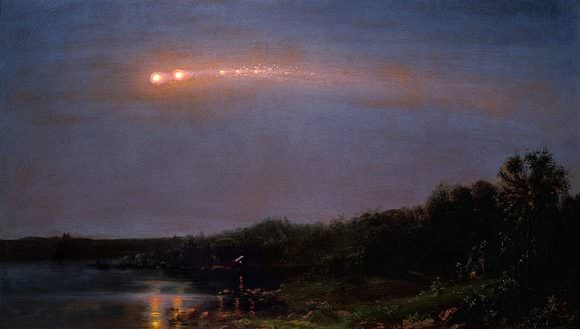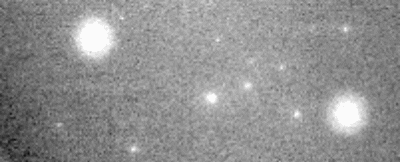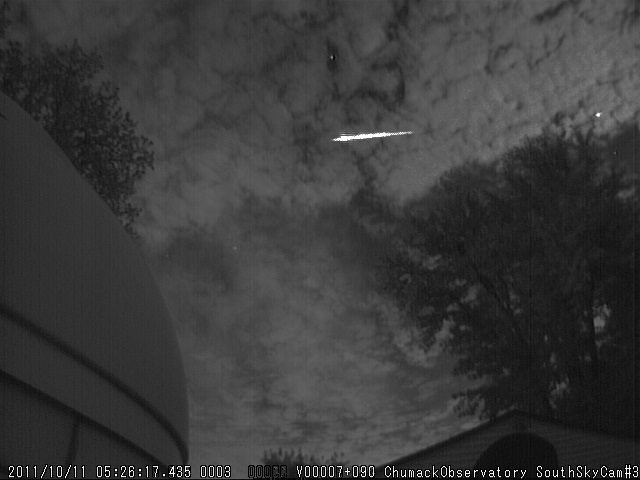It happens a few times every year.
Last week, we poured our morning coffee, powered up our laptop and phone, and prepared to engage the day.
It wasn’t long before the messages started pouring in. ‘Bright fireball over the U.S. West Coast!’ ‘Major event lights up the California skies!’ and variations thereof. Memories of Chelyabinsk came immediately to mind. A bit of digging around ye ole web revealed video and a few authentic stills from the event.
Now, I always like to look these over myself before reading just what other experts might think. Chelyabinsk immediately grabbed our attention when we saw the first videos recording the shock wave of sound generated by the blast. ‘That sucker was close,’ we realized.
Thursday’s (Wednesday evening Pacific Time) event was less spectacular, but still interesting: the nighttime reentry of the Long March CZ-7 rocket body NORAD ID 2016-042E as it broke up over the U.S. West Coast.
How do we know this, and what do we look for? Is that flash a meteor, bolide, reentry or something stranger still?
Most good meteor footage comes from video recorders that are already up and running when the event occurs, to include security and dashboard cameras, and mobile phones already recording another event, such as a concert or game. How fast can YOU have your smartphone camera out and running? We only recently learned that a quick double tap of the home button will bring the camera on our Android to bear, no unlock needed.
If the event occurs on a Friday or Saturday night with lots of folks out on the town on a clear evening, we might see multiple captures come streaming-in of the event. Just such a fireball was witnessed over the United Kingdom on Friday evening, September 21st, 2012.
Likewise, the fakes are never far behind. We’ve seen ’em all, though you’re welcome to try and stump us. Such ‘meteor-wrongs’ that are commonly circulated as authentic are the reentry of Mir, the 1992 Peekskill meteor, Chelyabinsk, the reentry of Hayabusa, and screen grabs from the flick Armageddon… has anyone ever been fooled by this one?
Meteors generally have a very swift motion, and occur with a greater frequency as the observer rotates forward into the path of Earth’s motion around the Sun past local midnight. Remember, it’s the front of the windshield that picks up the bugs rolling down the highway.
Evening meteors, however, can have a dramatic slow, stately motion across the sky, as they struggle to catch up with the Earth. If they reach a brilliance of magnitude -14 — about one whole magnitude brighter than a Full Moon — said meteor is known as a bolide.
Sometimes, such a fireball can begin shedding fiery debris, in a dramatic display known as a meteor train or meteor precession. Such an event was witnessed over the northeastern United States on July 20th, 1860.

Bright meteors may exhibit colors, hinting at chemical competition. Green for nickel (Not kryptonite!) is typically seen. MeteoriteMen’s Geoffrey Notkin once told us a good rule of thumb: if you hear an accompanying sonic boom a few minutes after seeing a meteor, it’s close. Folks often think what they saw went down behind a hill or tree, when it was actually likely more than 50 miles distant — if it hit the ground at all.
Is that a meteor or a reentry? Reentries move slower still, and will shed lots of debris. Here’s what we’re looking at to judge suspect sighting as a reentry:
Heavens-Above: A great clearing house for satellite passes by location. One great tool is that Heavens-Above will generate a pass map for your location juxtaposed over a sky chart.
Aerospace Corp current reentries: Follows upcoming reentries of larger debris with refined orbits.
Space-Track: The U.S. Joint Space Operations Command’s tracking center for artificial objects in orbit around Earth. Access is available to backyard satellite spotters with free registration. The most accurate source for swiftly evolving orbital elements.
SeeSat-L: This message board always lights up with chatter whenever a possible reentry lights up the skies worldwide.
Stranger Skies
Bizarre sights await the keen eyed. A tumbling rocket booster can often flare in a manner similar to Iridium satellites. Satellites way out in geostationary orbit can flare briefly into naked eye visibility during ‘GEOSat flare season’ near the weeks surrounding either equinox.
Some gamma ray bursts, such as GRB 080319B flare up briefly above magnitude +6 into naked eye visibility from far across the Universe. As of yet, there’s never been a reliable observer sighting of such an event, though it should be possible… probably someone far back in humanity’s history witnessed just such a brief flash in the sky, pausing silently to wonder just what it was…

Going further back still, a nearby supernova or gamma-ray burst would leave a ghostly blue afterglow from Cerenkov radiation as it pummeled our atmosphere… though it would be a deadly planet-sterilizing indigo glow, not something you’d want to see. Thankfully, we live in the ‘Era of Mediocrity,’ safely outside of the 25-50 light year ‘kill zone’ for any potential supernova.
And what if those lights in the sky really were the vanguard of an alien invasion force? Well, if they really did land rayguns ablaze on the White House lawn, you’ll read it first here on Universe Today!


Hey Now! Yes! I saw it while ‘Up the mountain’ doing some star gazing last Wed. Night That re-entry was a very imprssive sight! In retrospect I’d have to say that it was probably the brightest re-entry sequence I’ve ever seen… It was so dang bright! Had me worried there for a moment. Whereas some observers in Nevada reported hearing a sonic boom from the object… from my vantage point some 75 miles north and a bit west of San Francisco near the coast, I expected but did not hear one. Still, very impressive! Cheers…
Last Saturday Night, I was ‘up the mountain’ again until 2am. This time I saw several early Perseid meteor fireballs… But they were much faster and nowhere near as bright. Clear here.. I think I’ll end up the hill tonight? Want to go? Then, let’s roll this rock!
David the general rule of thumb for a natural event or man made fireball is, if a fire ball is traveling three degrees a second or faster it most likely a natural event ,a fire ball meteor. If traveling less than three degrees a second most like man made fireball.
To help people better understand degree measurements in the sky it real easy
1/2 degree is about the average width of a number 2 pencil eraser held at arms length.
1 degree is about the width of a single index finger held out in front of you at arms length.
2 degrees is about the width of your thumb held at arms length.
5 degrees is about the width of your three middle fingers held at arms length.
10 degrees is about the width of your fist ,side to side, at arms length.
20 degrees is about the width of your all fingers and thumb spread wide apart out in front of you at arms length.
Using this method to measure degrees is easy to learn and can give any one a basic approximate system to learn how to measure degree distances across the sky.
All I knew before was the thumb. Thanks for hipping me to the rest! 🙂